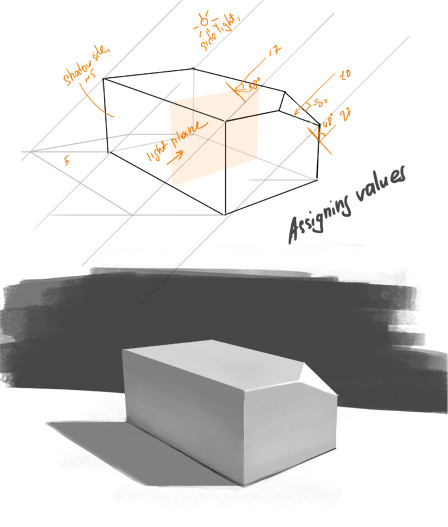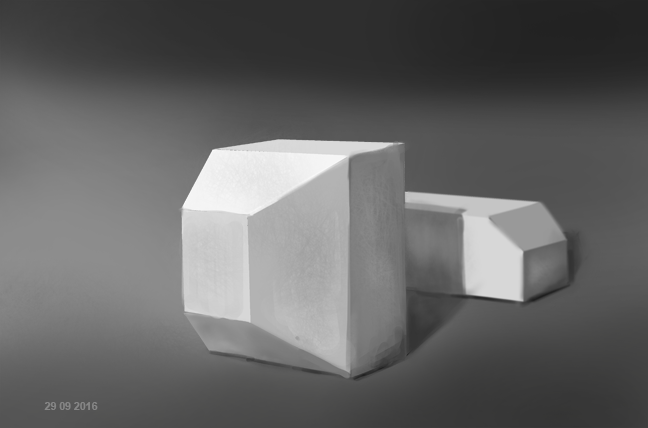11-30-2016, 07:47 AM
Hey Cyan! Scott Robertson writes a lot about shading matte forms in his How to render book.
Objects look metal because the value range on same planes is very high. In other words, there's too much contrast. The bounce light is also very strong. On some forms, it varies almost from white to black, it should be more subtle. Try making a paper cube, cylinder, maybe a ping pong ball, take your desk lamp, maybe put your object in a box to avoid ambient light, and observe.
As for the cast shadows, it does not seem like you know where the the ground plane is and like you haven't build your shadows but just guessed them.
If you want a more technical approach to controlling your values, check out Scott Robertson's How to render book.
I can suggest a tip from that book. It's "halfway to black" rule. First, make a scale from 1 to 10 if you haven't yet, almost all artists recommend having it, Daarken and Villppuu and Fluharty and many others. Here's mine.

Then, decide what is the true value of the object. Say, the cube is white, so it's 0. Paint the most lit surface with white. In this case, the value of the cast shadow shall be halfway to 10, that is 5. The value range of the other 2 surfases will be between 0 and 5 and depends on the angle of light falling on the surface
Here's some studies I practiced back in the day, no time for a paintover right now, but we could hang out in Crimson Hangouts and practice some day if you want.


This halfway to black rule applies to all forms, not. He's got a lot more info in his book on different forms, with explanations and examples. He also explains how to build cast shadows. I strongly recommend this book if you want to go in-depth and really understand how light and shadow works, there's also has a DVD for it.
Objects look metal because the value range on same planes is very high. In other words, there's too much contrast. The bounce light is also very strong. On some forms, it varies almost from white to black, it should be more subtle. Try making a paper cube, cylinder, maybe a ping pong ball, take your desk lamp, maybe put your object in a box to avoid ambient light, and observe.
As for the cast shadows, it does not seem like you know where the the ground plane is and like you haven't build your shadows but just guessed them.
If you want a more technical approach to controlling your values, check out Scott Robertson's How to render book.
I can suggest a tip from that book. It's "halfway to black" rule. First, make a scale from 1 to 10 if you haven't yet, almost all artists recommend having it, Daarken and Villppuu and Fluharty and many others. Here's mine.

Then, decide what is the true value of the object. Say, the cube is white, so it's 0. Paint the most lit surface with white. In this case, the value of the cast shadow shall be halfway to 10, that is 5. The value range of the other 2 surfases will be between 0 and 5 and depends on the angle of light falling on the surface
Here's some studies I practiced back in the day, no time for a paintover right now, but we could hang out in Crimson Hangouts and practice some day if you want.


This halfway to black rule applies to all forms, not. He's got a lot more info in his book on different forms, with explanations and examples. He also explains how to build cast shadows. I strongly recommend this book if you want to go in-depth and really understand how light and shadow works, there's also has a DVD for it.









